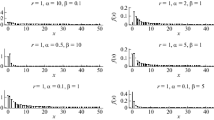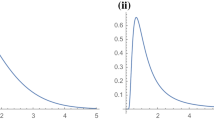Abstract
This paper contains some alternative methods for estimating the parameters in the beta binomial and truncated beta binomial models. These methods are compared with maximum likelihood on the basis of Asymptotic Relative Efficiency (ARE). For the beta binomial distribution a simple estimator based on moments or ratios of factorial moments has high ARE for most of the parameter space and it is an attractive and viable alternative to computing the maximum likelihood estimator. It is also simpler to compute than an estimator based on the mean and zeros, proposed by Chatfield and Goodhart (1970,Appl. Statist.,19, 240–250), and has much higher ARE for most part of the parameter space. For the truncated beta binomial, the simple estimator based on two moment relations does not behave quite as well as for the BB distribution, but a simple estimator based on two linear relations involving the first three moments and the frequency of “ones” has extremely high ARE. Some examples are provided to illustrate the procedure for the two models.
Similar content being viewed by others
References
Anscombe, F. J. (1950). Sampling theory of the negative binomial and the logarithmic series distributions,Biometrika,37, 358–382.
Barankin, E. W. and Gurland, J. (1951).On Asymptotically Normal Efficient Estimators, University of California Publications in Statistics,1, 89–129.
Brooks, R. J. (1984). Approximate likelihood ratio tests in the analysis of Beta Binomial data,Appl. Statist.,33(3), 285–289.
Chatfield, C. and Goodhart, G. J. (1970). The beta-binomial model for consumer purchasing behavior,Appl. Statist.,19, 240–250.
Conte, S. D. and deBoor, C. (1980).Elementary Numerical Analysis, 3rd ed., McGraw Hill Book Company, New York.
Griffiths, D. A. (1973). Maximum likelihood estimation for the beta binomial distributions and an application to the household distribution of the total number of cases of a disease,Biometrics,29, 637–648.
Heasman, M. A. and Reid, D. D. (1961). Theory and observations in family epidemics of the common cold,Brit. J. Prev. Soc. Med.,15, 12–16.
Kupper, L. L. and Haseman, J. K. (1978). The use of a correlated binomial model for the analysis of certain texicological experiments,Biometrics,34, 69–76.
Kupper, L. L., Portier, C., Hogan, M. D. and Yamomoto, E. (1986). The impact of litter effects on dose-response modeling in teratology,Biometrics,42, 85–98.
Nissen-Meyer, S. (1964). Evaluation of screening in medical diagnosis,Biometrics,20, 730–755.
Pack, S. E. (1986). Hypothesis testing for proportions with over dispersion,Biometrics,42, 967–972.
Paul, S. R. (1982). Analysis of proportions of affected fetuses in teratology experiments,Biometrics,38, 361–370.
Shenton, L. R. (1950). Maximum likelihood and the efficiency of the method moment,Biometrika,37, 111–116.
Skellam, J. G. (1948). A probability distribution derived from the binomial distribution by regarding the probability of a success as variable between the sets of trials,J. Roy. Statist. Soc. Ser. B,10, 257–261.
Skurnick, J. H. (1990). Small sample power calculations based on the Beta Binomial model for comparison of probabilities, paper presented at the ENAR meeting, Baltimore, Maryland.
Tarone, R. E. (1982). The use of historical control information in testing for a trend in proportions,Biometrics,34, 69–76.
Tarone, R. E., Chu, K. C. and Ward, J. M. (1981). Variability in the rates of some common naturally occurring tumors in F344 rats and B6C3F, mice,Journal of the National Cancer Institute,66, 1175–1181.
Tripathi, R. C. (1975). Families of discrete distributions with probability generating function involving hypergeometric functions, Ph.D. Thesis, Department of Statistics, University of Wisconsin, Madison.
Williams, D. A. (1975). The analysis of binary responses from toxicological experiments involving reproduction and teratogenicity,Biometrics,31, 949–952.
Williams, D. A. (1982). Extra binomial variation in logistic linear models,Appl. Statist.,31(2), 144–148.
Williams, D. A. (1988). Estimation bias using the beta binomial distribution in teratology,Biometrics,44, 305–309.
Author information
Authors and Affiliations
About this article
Cite this article
Tripathi, R.C., Gupta, R.C. & Gurland, J. Estimation of parameters in the beta binomial model. Ann Inst Stat Math 46, 317–331 (1994). https://doi.org/10.1007/BF01720588
Received:
Revised:
Issue Date:
DOI: https://doi.org/10.1007/BF01720588




